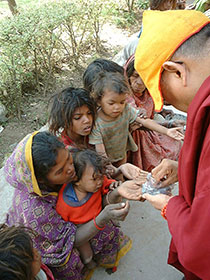- Home
- FPMT Homepage
Foundation for the Preservation of the Mahayana Tradition
The FPMT is an organization devoted to preserving and spreading Mahayana Buddhism worldwide by creating opportunities to listen, reflect, meditate, practice and actualize the unmistaken teachings of the Buddha and based on that experience spreading the Dharma to sentient beings. We provide integrated education through which people’s minds and hearts can be transformed into their highest potential for the benefit of others, inspired by an attitude of universal responsibility and service. We are committed to creating harmonious environments and helping all beings develop their full potential of infinite wisdom and compassion. Our organization is based on the Buddhist tradition of Lama Tsongkhapa of Tibet as taught to us by our founders Lama Thubten Yeshe and Lama Thubten Zopa Rinpoche.
- Willkommen
Die Stiftung zur Erhaltung der Mahayana Tradition (FPMT) ist eine Organisation, die sich weltweit für die Erhaltung und Verbreitung des Mahayana-Buddhismus einsetzt, indem sie Möglichkeiten schafft, den makellosen Lehren des Buddha zuzuhören, über sie zur reflektieren und zu meditieren und auf der Grundlage dieser Erfahrung das Dharma unter den Lebewesen zu verbreiten.
Wir bieten integrierte Schulungswege an, durch denen der Geist und das Herz der Menschen in ihr höchstes Potential verwandelt werden zum Wohl der anderen – inspiriert durch eine Haltung der universellen Verantwortung und dem Wunsch zu dienen. Wir haben uns verpflichtet, harmonische Umgebungen zu schaffen und allen Wesen zu helfen, ihr volles Potenzial unendlicher Weisheit und grenzenlosen Mitgefühls zu verwirklichen.
Unsere Organisation basiert auf der buddhistischen Tradition von Lama Tsongkhapa von Tibet, so wie sie uns von unseren Gründern Lama Thubten Yeshe und Lama Thubten Zopa Rinpoche gelehrt wird.
- Bienvenidos
La Fundación para la preservación de la tradición Mahayana (FPMT) es una organización que se dedica a preservar y difundir el budismo Mahayana en todo el mundo, creando oportunidades para escuchar, reflexionar, meditar, practicar y actualizar las enseñanzas inconfundibles de Buda y en base a esa experiencia difundir el Dharma a los seres.
Proporcionamos una educación integrada a través de la cual las mentes y los corazones de las personas se pueden transformar en su mayor potencial para el beneficio de los demás, inspirados por una actitud de responsabilidad y servicio universales. Estamos comprometidos a crear ambientes armoniosos y ayudar a todos los seres a desarrollar todo su potencial de infinita sabiduría y compasión.
Nuestra organización se basa en la tradición budista de Lama Tsongkhapa del Tíbet como nos lo enseñaron nuestros fundadores Lama Thubten Yeshe y Lama Zopa Rinpoche.
A continuación puede ver una lista de los centros y sus páginas web en su lengua preferida.
- Bienvenue
L’organisation de la FPMT a pour vocation la préservation et la diffusion du bouddhisme du mahayana dans le monde entier. Elle offre l’opportunité d’écouter, de réfléchir, de méditer, de pratiquer et de réaliser les enseignements excellents du Bouddha, pour ensuite transmettre le Dharma à tous les êtres. Nous proposons une formation intégrée grâce à laquelle le cœur et l’esprit de chacun peuvent accomplir leur potentiel le plus élevé pour le bien d’autrui, inspirés par le sens du service et une responsabilité universelle. Nous nous engageons à créer un environnement harmonieux et à aider tous les êtres à épanouir leur potentiel illimité de compassion et de sagesse. Notre organisation s’appuie sur la tradition guéloukpa de Lama Tsongkhapa du Tibet, telle qu’elle a été enseignée par nos fondateurs Lama Thoubtèn Yéshé et Lama Zopa Rinpoché.
Visitez le site de notre Editions Mahayana pour les traductions, conseils et nouvelles du Bureau international en français.
Voici une liste de centres et de leurs sites dans votre langue préférée
- Benvenuto
L’FPMT è un organizzazione il cui scopo è preservare e diffondere il Buddhismo Mahayana nel mondo, creando occasioni di ascolto, riflessione, meditazione e pratica dei perfetti insegnamenti del Buddha, al fine di attualizzare e diffondere il Dharma fra tutti gli esseri senzienti.
Offriamo un’educazione integrata, che può trasformare la mente e i cuori delle persone nel loro massimo potenziale, per il beneficio di tutti gli esseri, ispirati da un’attitudine di responsabilità universale e di servizio.
Il nostro obiettivo è quello di creare contesti armoniosi e aiutare tutti gli esseri a sviluppare in modo completo le proprie potenzialità di infinita saggezza e compassione.
La nostra organizzazione si basa sulla tradizione buddhista di Lama Tsongkhapa del Tibet, così come ci è stata insegnata dai nostri fondatori Lama Thubten Yeshe e Lama Zopa Rinpoche.
Di seguito potete trovare un elenco dei centri e dei loro siti nella lingua da voi prescelta.
- 欢迎 / 歡迎
简体中文
“护持大乘法脉基金会”( 英文简称:FPMT。全名:Foundation for the Preservation of the Mahayana Tradition) 是一个致力于护持和弘扬大乘佛法的国际佛教组织。我们提供听闻,思维,禅修,修行和实证佛陀无误教法的机会,以便让一切众生都能够享受佛法的指引和滋润。
我们全力创造和谐融洽的环境, 为人们提供解行并重的完整佛法教育,以便启发内在的环宇悲心及责任心,并开发内心所蕴藏的巨大潜能 — 无限的智慧与悲心 — 以便利益和服务一切有情。
FPMT的创办人是图腾耶喜喇嘛和喇嘛梭巴仁波切。我们所修习的是由两位上师所教导的,西藏喀巴大师的佛法传承。
繁體中文
護持大乘法脈基金會”( 英文簡稱:FPMT。全名:Found
ation for the Preservation of the Mahayana Tradition ) 是一個致力於護持和弘揚大乘佛法的國際佛教組織。我們提供聽聞, 思維,禪修,修行和實證佛陀無誤教法的機會,以便讓一切眾生都能 夠享受佛法的指引和滋潤。 我們全力創造和諧融洽的環境,
為人們提供解行並重的完整佛法教育,以便啟發內在的環宇悲心及責 任心,並開發內心所蘊藏的巨大潛能 — 無限的智慧與悲心 – – 以便利益和服務一切有情。 FPMT的創辦人是圖騰耶喜喇嘛和喇嘛梭巴仁波切。
我們所修習的是由兩位上師所教導的,西藏喀巴大師的佛法傳承。 察看道场信息:
- FPMT Homepage
- News/Media
-
- Study & Practice
-
-
- About FPMT Education Services
- Latest News
- Programs
- New to Buddhism?
- Buddhist Mind Science: Activating Your Potential
- Heart Advice for Death and Dying
- Discovering Buddhism
- Living in the Path
- Exploring Buddhism
- FPMT Basic Program
- FPMT Masters Program
- FPMT In-Depth Meditation Training
- Maitripa College
- Lotsawa Rinchen Zangpo Translator Program
- Universal Education for Compassion & Wisdom
- Online Learning Center
-
- Prayers & Practice Materials
- Overview of Prayers & Practices
- Full Catalogue of Prayers & Practice Materials
- Explore Popular Topics
- Benefiting Animals
- Chenrezig Resources
- Death & Dying Resources
- Lama Chopa (Guru Puja)
- Lama Zopa Rinpoche: Compendium of Precious Instructions
- Lama Zopa Rinpoche: Life Practice Advice
- Lama Zopa Rinpoche Practice Series
- Lamrim Resources
- Mantras
- Prayer Book Updates
- Purification Practices
- Sutras
- Thought Transformation (Lojong)
- Audio Materials
- Dharma Dates - Tibetan Calendar
- Translation Services
- Publishing Services
- Ways to Offer Support
- Prayers & Practice Materials
-
- Teachings and Advice
- Find Teachings and Advice
- Lama Zopa Rinpoche Advice Page
- Lama Zopa Rinpoche: Compendium of Precious Instructions
- Lama Zopa Rinpoche Video Teachings
- ༧སྐྱབས་རྗེ་བཟོད་པ་རིན་པོ་ཆེ་མཆོག་ནས་སྩལ་བའི་བཀའ་སློབ་བརྙན་འཕྲིན།
- Podcasts
- Lama Yeshe Wisdom Archive
- Buddhism FAQ
- Dharma for Young People
- Resources on Holy Objects
- Teachings and Advice
-
-
*If a menu item has a submenu clicking once will expand the menu clicking twice will open the page.
-
-
- Centers
-
- Teachers
-
- Projects
-
-
-
-
*If a menu item has a submenu clicking once will expand the menu clicking twice will open the page.
-
-
- FPMT
-
-
-
-
-
The root of your life’s problems becomes non-existent when you cherish others.
Lama Zopa Rinpoche
-
-
-
- Shop
-
-
-
The Foundation Store is FPMT’s online shop and features a vast selection of Buddhist study and practice materials written or recommended by our lineage gurus. These items include homestudy programs, prayers and practices in PDF or eBook format, materials for children, and other resources to support practitioners.
Items displayed in the shop are made available for Dharma practice and educational purposes, and never for the purpose of profiting from their sale. Please read FPMT Foundation Store Policy Regarding Dharma Items for more information.
-
-
Lama Zopa Rinpoche News and Advice
28
Lama Zopa Rinpoche recently offered advice on practices to do to protect from the coronavirus. As part of the advice, Rinpoche recommended a specific puja be done. The puja has now been arranged at Sera Je Monastery in India. It has also been arranged to be done in Tibet.
Rinpoche now offers this additional advice to protect from the coronavirus:
Rinpoche says that in addition to his earlier advice people should also recite “The Prayer Liberating Sakya from Disease” ( PDF, Audio). The prayer comes from the great yogi Thangtong Gyalpo (1385–1464) and is for healing from disease.
While doing this prayer, students should look at an image of Thangtong Gyalpo. (The image of Thangtong Gyalpo below is from a thangka in Lama Zopa Rinpoche’s house.)
Rinpoche added, “the previous mantras are to protect yourself and others, but this prayer from Thangtong Gyalpo is to heal the disease in China and for it not to spread out to other countries. So it is to protect the country. And anyone in the world can recite this prayer.”
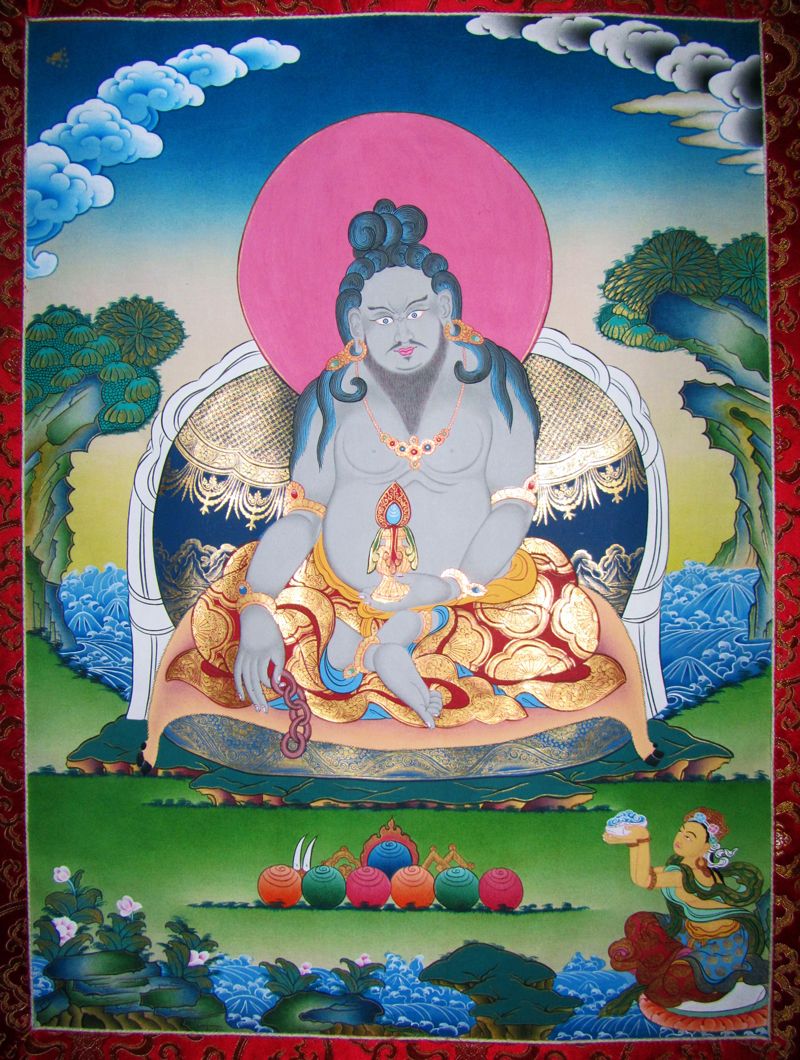
Thangtong Gyalpo
Lama Zopa Rinpoche’s earlier advice to protect from the coronavirus is here:
https://fpmt.org/lama-zopa-rinpoche-news-and-advice/advice-from-lama-zopa-rinpoche/lama-zopa-rinpoche-offers-advice-to-protect-from-the-coronavirus/
Lama Zopa Rinpoche is the spiritual director of the Foundation for the Preservation of Mahayana Tradition (FPMT), a Tibetan Buddhist organization dedicated to the transmission of the Mahayana Buddhist tradition and values worldwide through teaching, meditation and community service.
25
Lama Zopa Rinpoche was asked what can be done for the outbreak of the coronavirus. UPDATE: Rinpoche has offered additional advice.
Rinpoche advised the arrangement of a wrathful fire puja offered by Jhado Rinpoche in South India at Sera Je Monastery. [This was done. Also a Most Secret Hayagriva tsog kong was offered at Kopan Monastery and at Sera Je Monastery, and a number of other pujas were arranged in India and Nepal.]
Individual students can do the following mantra recitation practice:
As a motivation before reciting the two mantras, Rinpoche said it’s best if people can do The Method to Transform a Suffering Life into Happiness (Including Enlightenment) with Additional Practices, which is the daily morning practice Rinpoche has put together. That is best. But if that is too much, then do the lamrim motivation, which is just The Method without additional practices. [In other words, do the recitation on pages 7–14 of the booklet and stop at the Additional Practices, which begin with the “Blessing the Speech” section.] So at least do that part as a motivation before reciting the mantras.
- Recite Vajra Armor mantra, which is a famous mantra for healing. You can do the entire Vajra Armor Protection Wheel if you want. Otherwise, just do the mantra:
HŪṂ VAJRA PHAṬ* / OṂ PADMAŚHAVARI PHAṬ / NÄN PAR SHIG / NĀGANAN / TADYATHĀ / SARVAVIRITA / HANA HANA / VAJRENA RAKṢHA RAKṢHA SVĀHĀ
*Lama Zopa Rinpoche often gives the oral transmission of the mantra with the additional syllables “HŪṂ VAJRA PHAṬ,” as was taught by Trulshik Rinpoche. These syllables are recited with each recitation of the mantra. There are other lineages of the mantra that do not contain these syllables.
After you finish reciting the mantra, hold your hand in front of your mouth and blow the air up, so it goes into your nostrils.
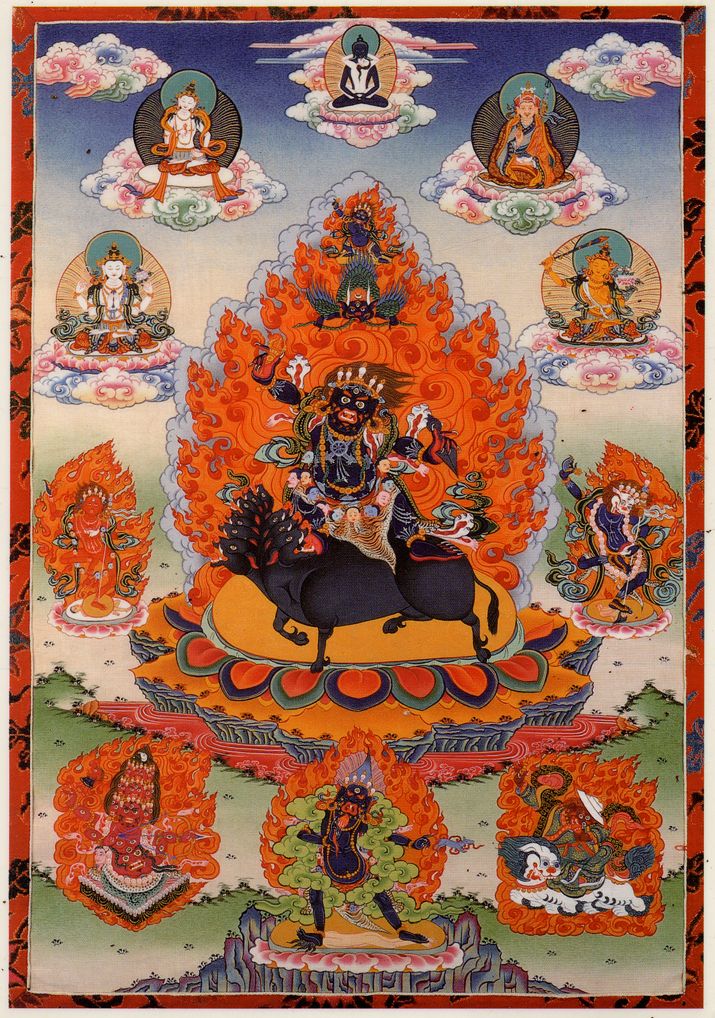
Vajra Armor
- Then also recite Black Manjushri mantra. The Meditation-Recitation of Black Manjushri is also good to do if you want. Otherwise, just do the mantra:
OṂ TRA SÖ / CHHU SÖ / DUR TA SÖ / DUR MI SÖ / NYING GO LA CHHÖ / KHA LA JAḤ KAṂ ŚHAṂ TRAṂ / BÄ PHAṬ SVĀHĀ
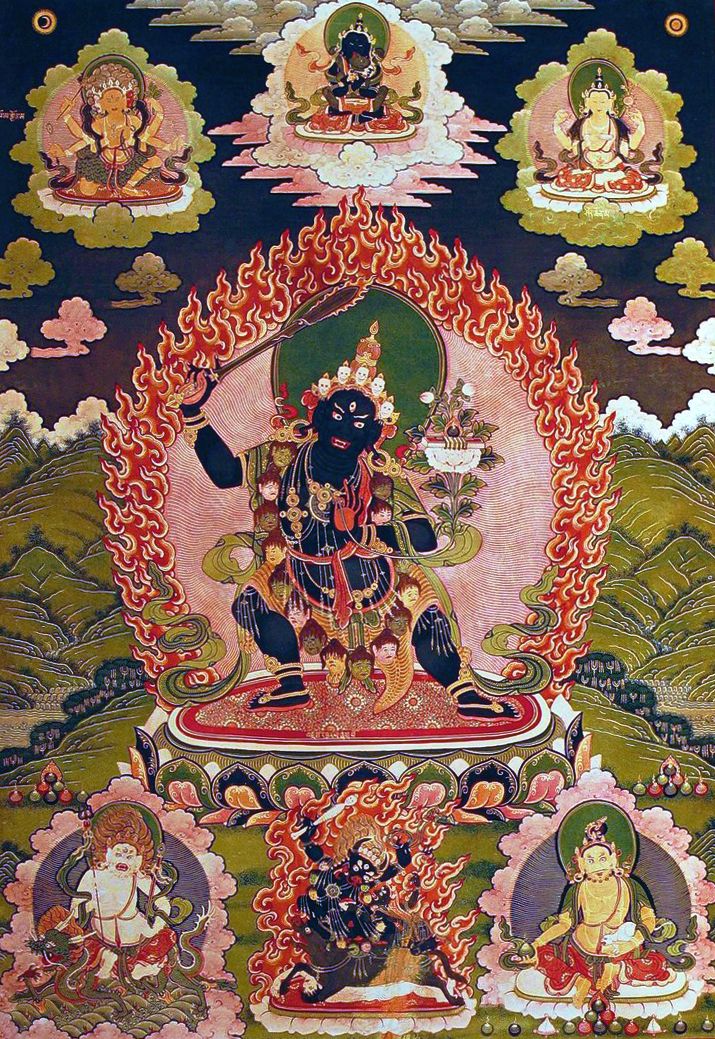
Black Manjushri
Then at the end, do dedication prayers:
JANG CHHUB SEM CHHOG RIN PO CHHE
May the precious supreme bodhichitta
MA KYE PA NAM KYE GYUR CHIG
Not yet born arise.
KYE PA NYAM PA ME PA YI
May that arisen not decline,
GONG NÄ GONG DU PHEL WAR SHOG
But increase more and more.
GE WA DI YI NYUR DU DAG
Due to this virtue, may I quickly
LA MA SANG GYÄ DRUB GYUR NÄ
Become a Guru-Buddha,
DRO WA CHIG KYANG MA LÜ PA
And lead all transmigratory beings,
DE YI SA LA GÖ PAR SHOG
Without exception, to that state.
Due to all the merits of the three times collected by me, the numberless buddhas, and the numberless sentient beings, may all wars, sickness, famine, torture, poverty, and economic problems in the world, and all dangers of earth, water, fire, and wind, be pacified immediately, and may perfect peace and happiness prevail in everyone’s hearts and lives. May the Buddhadharma last for a long time, and may the sentient beings in this world meet the Buddhadharma and achieve enlightenment as quickly as possible.
Due to all the past, present, and future merits collected by me and all the merits of the three times collected by the numberless buddhas and numberless sentient beings, which are completely empty of existing from their own side, may I, who am completely empty of existing from my own side, achieve the state of full enlightenment, which is completely empty of existing from its own side, and lead all sentient beings, who are completely empty of existing from their own side, to that state, which is completely empty of existing from its own side, by myself alone, who is completely empty of existing from my own side.
Scribe: Ven. Holly Ansett, January 23, 2020.
Links to the practices in this advice can be found here:
https://fpmt.org/education/prayers-and-practice-materials/
Additional advice from Lama Zopa Rinpoche for protection from coronavirus:
https://fpmt.org/lama-zopa-rinpoche-news-and-advice/advice-from-lama-zopa-rinpoche/additional-advice-from-lama-zopa-rinpoche-to-protect-from-the-coronavirus/
Lama Zopa Rinpoche is the spiritual director of the Foundation for the Preservation of Mahayana Tradition (FPMT), a Tibetan Buddhist organization dedicated to the transmission of the Mahayana Buddhist tradition and values worldwide through teaching, meditation and community service.
13
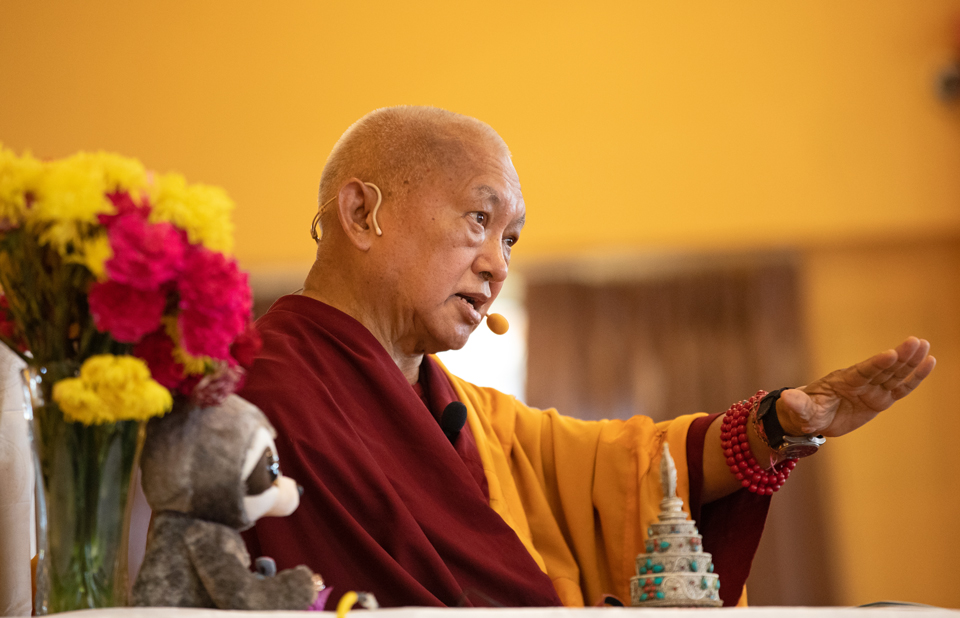
Lama Zopa Rinpoche teaching at the 52nd Kopan Course, Kopan Monastery, Nepal, December 2019. Photo by Neal Patrick.
Lama Zopa Rinpoche gave this advice for a practice to do for world peace in June 2004.
My dear Dharma brothers and sisters,
It looks like there could be a lot of violence happening in Iraq.
It comes out very beneficial if people read the Golden Light Sutra at least 1,000 times and dedicate it for peace in Iraq and the rest of world. This will at least reduce the killing and suffering.
The holy Sutra of Golden Light is the king of the sutras (Ser.ö dam.päi do wang.gyi gyälpo). It is extremely powerful and fulfills the wishes, as well all the peace and happiness, of all sentient beings, up to enlightenment. It is also powerful for world peace, your own protection, and the protection of your country and the world. Also, it has great healing power for people in the country, even if only one person reads it.
I am offering my suggestion for people who desire peace for themselves and for others. This is the spiritual, or Dharma, way to bring peace that doesn’t require you to harm others, doesn’t require you to criticize others or even to demonstrate against others, yet can accomplish peace. So I hope some people, Buddhists and even non-Buddhists who desire world peace, will read this text.
This also protects individuals and the country from what are labeled natural disasters—of the wind element, fire element, earth element, and water element—such as earthquakes, floods, cyclones, fires, tornadoes, etc. They are not natural, because they come from causes and conditions that make dangers happen. They come from past inner negative thoughts and actions of people, and external conditions. Their creation is not natural, it happens from our own side.
So here, I would like to make this request with my two palms together to please recite the Sutra of Golden Light for world peace as much as you can.
Thank you very much.
With much love and prayers,
Lama Zopa
Find resources on the Golden Light Sutra and links to the sutra in fifteen languages:
https://fpmt.org/education/prayers-and-practice-materials/sutras/golden-light-sutra/
Lama Zopa Rinpoche is the spiritual director of the Foundation for the Preservation of Mahayana Tradition (FPMT), a Tibetan Buddhist organization dedicated to the transmission of the Mahayana Buddhist tradition and values worldwide through teaching, meditation and community service.
- Tagged: golden light sutra, peace, world peace
10
Prayer for Peace
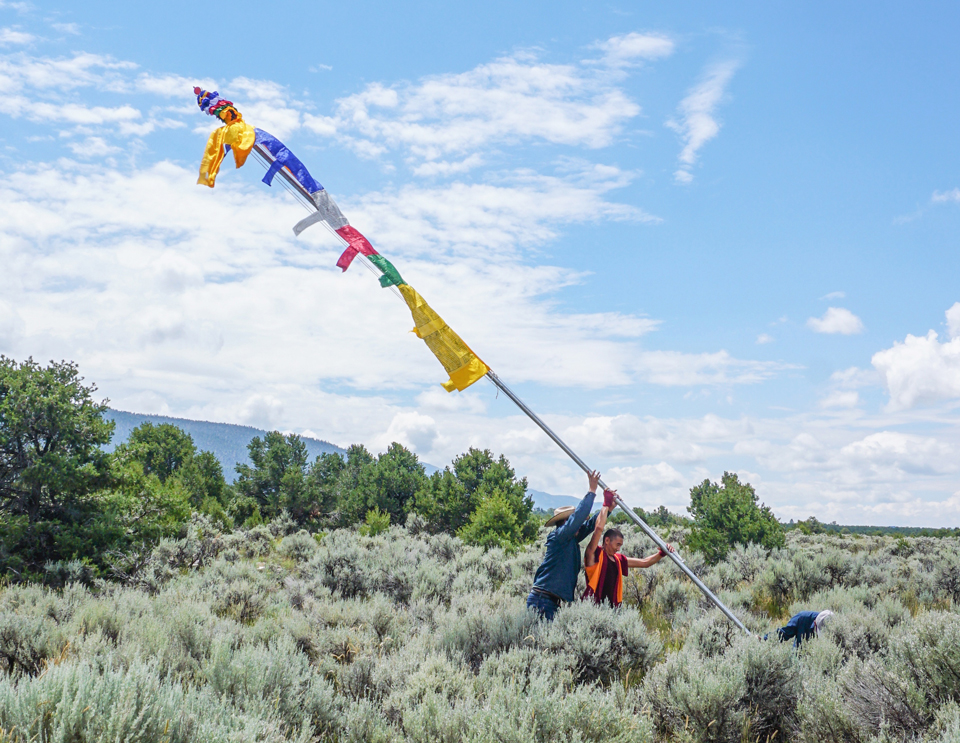
Putting up prayer flags, New Mexico, US, 2017. Photo by Ven. Lobsang Sherab.
“When there was unceasing war in Kham (Me Nyak), Tibet, and nobody was able to create harmony, the Great Lord Yogi (Thang Thong Gyalpo) came to Kham, generated bodhichitta, and just by merely saying these true words and sprinkling flowers, all the vicious minds (jealousy and anger) were completely pacified and the war that had been continuous, ceased. There were prosperous harvests and so forth. The country became auspicious and peaceful. This is blessed vajra speech,” Lama Zopa Rinpoche said as preface to his translation of a prayer by the great tantric yogi Thang Thong Gyalpo.
“… Through whatever merits have come from making this translation available, may wherever this text is (whichever country) and also by reading this prayer, cause all the people’s hearts be filled with loving kindness, bodhichitta, and the thought to only benefit and not harm. May the sun of peace and happiness arise and may any wars that are happening stop immediately. May there be harmony, peace, and may there never be war or violence again.” Rinpoche made this translation of Thang Thong Gyalpo’s “Prayer for Peace” after the 9/11 terrorist attacks of 2001 in the United States.
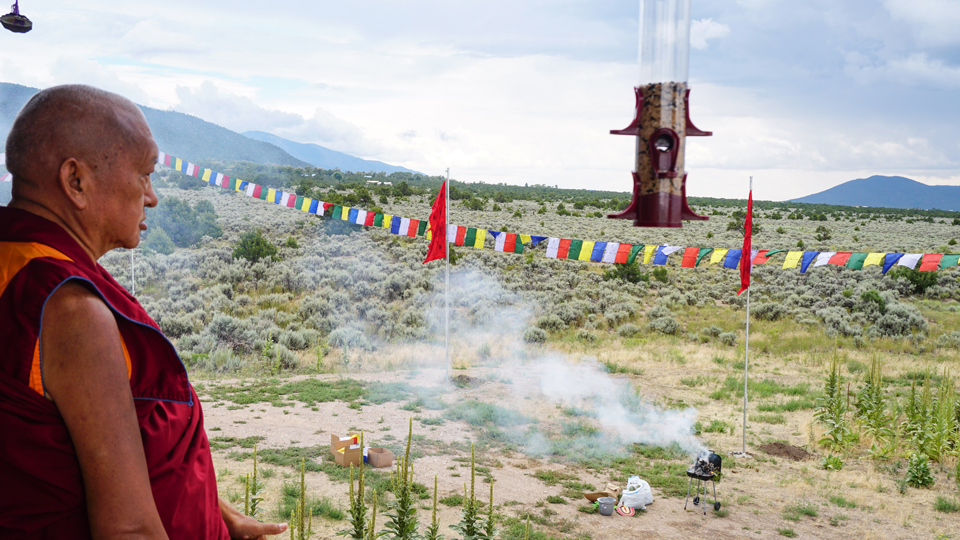
Lama Zopa Rinpoche observes while incense offerings are made while new prayer flags are hung, Taos, New Mexico, August 2017. Photo by Ven. Lobsang Sherab.
HERE ARE THE WORDS OF TRUTH PACIFYING THE DANGERS OF WEAPONS
OM MANI PADME HUM
Great Loving Victorious One (Maitreya Buddha), Transcendental Sublime Compassionate Eye Looking One,
Wrathful Victorious Hayagriva, Fully Accomplished Totally Pure (Jetsun) Tara and so forth,
Merely hearing your holy names eliminates all dangers,
Objects of refuge in the nature of compassion, please pay attention!When the sentient beings of the time of quarreling and five degenerations
By the explosion of the great ocean of evil karma and jealousy
Are tormented by the intensive suffering of fighting and quarreling
Please dry this up by the power of transcendental wisdom and compassion.By letting great rainfalls of the nectar of loving kindness fall
On the migratory beings who are inflaming the conflagration of hatred-fire
Please grant blessings with the recognition of each other like father-mother
Then increase happiness and auspiciousness.May the multitudes of the vicious evil spirits
Who enter the mental continuum and
Change it instantly to the mind of asura
From now on never run in this area (country/world).I am requesting for even all the sentient beings who have died in the war
To abandon from that time onward all the evil karma, cause and effect,
Then having entered and been born in the Blissful Field (Amitabha’s Pure Land)
To lead all others to that Pure Land.Please bless all those who are born and die (samsaric beings)
To have a long life, no sicknesses, to pacify all quarreling and fighting,
Enjoy the ten virtues, have rainfall at the right times, always have good harvests
And for all the habitat and inhabitants to be auspicious and increase.By the ultimate reality which is pure by nature,
By phenomena having ultimate reality, cause and result are unbetrayable,
And by the compassion of the Guru, Mind-seal Deity and Rare Sublime Ones,
May these pure extensive prayers be completed.
You can find the “Prayer Flag to Avert War” with Thang Thong Gyalpo’s “Prayer for Peace” in the FPMT Foundation Store, while supplies last:
https://shop.fpmt.org/Prayer-Flag-to-Avert-War_p_392.html
Many other prayer flags to send blessings out into the world are also available in the Foundation Store:
https://shop.fpmt.org/Prayer-Flags_c_159.html
This “Prayer for Peace” was originally posted by the Lama Yeshe Wisdom Archive, where you can read Rinpoche’s complete comments on it:
https://www.lamayeshe.com/advice/prayer-peace
Lama Zopa Rinpoche is the spiritual director of the Foundation for the Preservation of Mahayana Tradition (FPMT), a Tibetan Buddhist organization dedicated to the transmission of the Mahayana Buddhist tradition and values worldwide through teaching, meditation and community service.
- Tagged: peace, world peace
25
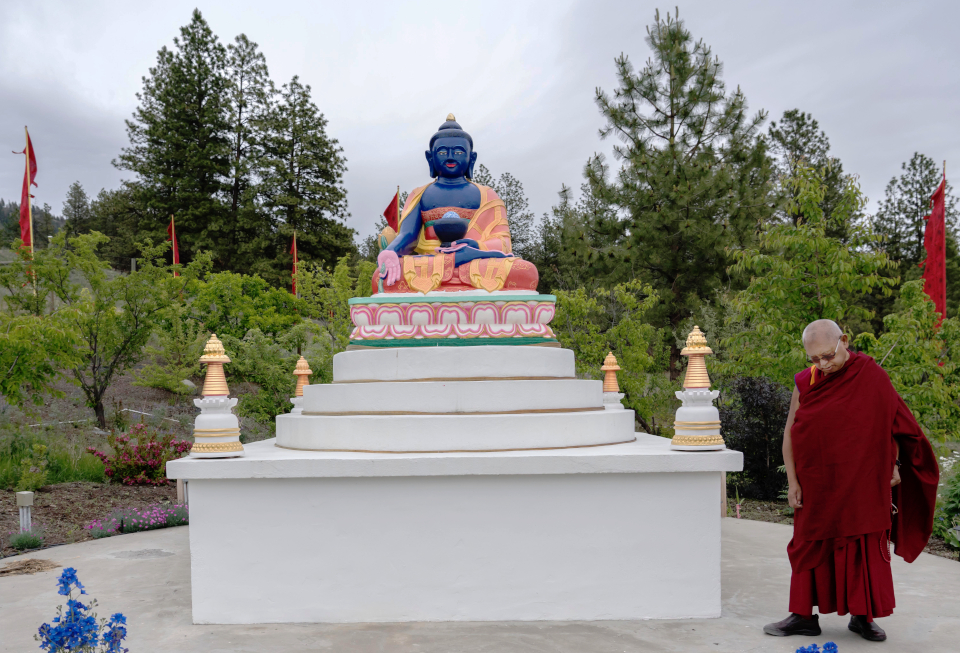
Lama Zopa Rinpoche circumambulating Medicine Buddha statue at Buddha Amitabha Pure Land, Washington, US, 2018. Photo by Ven. Lobsang Sherab.
Australia is experiencing what is becoming its worst fire season ever, affecting tens of thousands of people and countless animals.
Lama Zopa Rinpoche has given advice on several occasions on practices to do in order to dispel and protect from fire, which can be found in the PDF “Practices and Advice to Dispel Fires.” This advice includes instruction on Medicine Buddha practice, White Umbrella practice, the Heart Mantra of Arya Vairochana, Kshitigarbha practice, Chenrezig practice, and more.
You can also find additional instruction on practice to do in Rinpoche’s short advice given in 2017 on California wildfires. The Lama Yeshe Wisdom Archive also has a page for Rinpoche’s advice on fires.
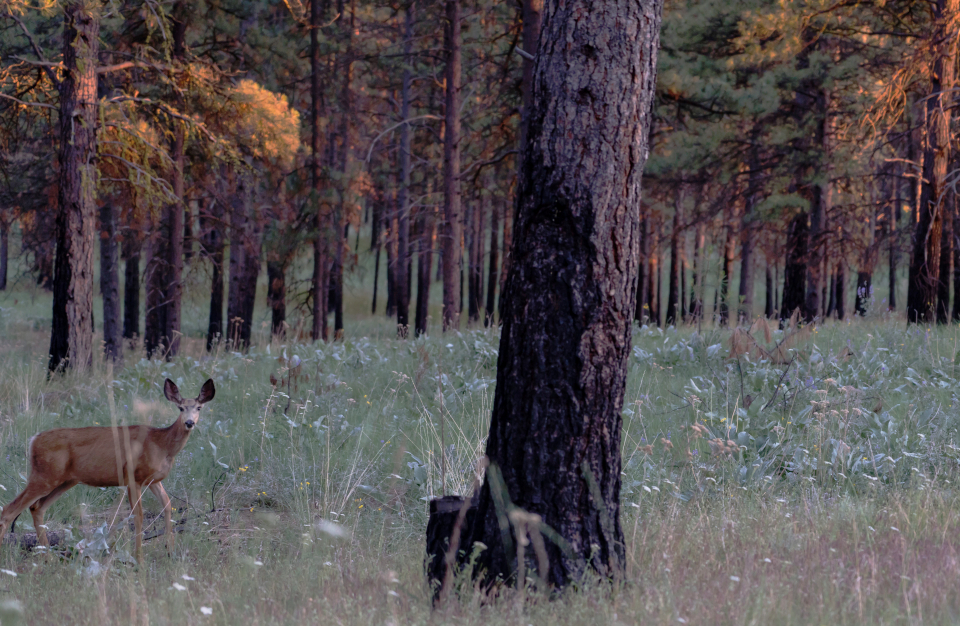
A deer friend at Amitabha Buddha Pure Land in an area affected by past wildfires, Washington, US, 2019. Photo by Ven. Lobsang Sherab.
Lama Zopa Rinpoche’s advice “Practices and Advice to Dispel Fires” can be found here:
https://fpmt.org/wp-content/uploads/teachers/zopa/advice/Fires-Practices-for-dispelling-1.pdf
Find links to recordings of Lama Zopa Rinpoche’s recent teachings from Nepal, Russia, Singapore, Latvia, France, and more:
https://fpmt.org/media/streaming/teachings-of-lama-zopa-rinpoche/
Lama Zopa Rinpoche is the spiritual director of the Foundation for the Preservation of Mahayana Tradition (FPMT), a Tibetan Buddhist organization dedicated to the transmission of the Mahayana Buddhist tradition and values worldwide through teaching, meditation and community service.
- Tagged: advice from lama zopa rinpoche, fire
24
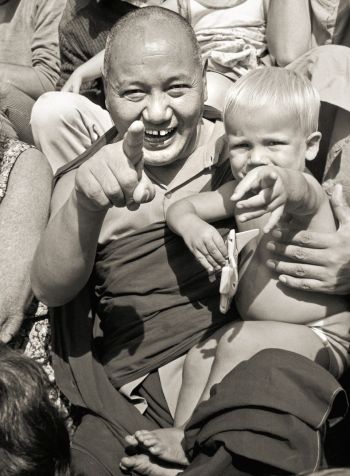
Lama Thubten Yeshe with a child at Maitreya Instituut, the Netherlands, 1981. Photo by Ina van Delden, courtesy Lama Yeshe Wisdom Archive.
When we see each other again on Christmas Eve for the celebration of Holy Jesus’ birth, let us do so in peace and with a good vibration and a happy mind. I think it would be wonderful. To attend the celebration with an angry disposition would be so sad. Come instead with a beautiful motivation and much love. Have no discrimination, but see everything as a golden flower, even your worst enemy. Then Christmas, which so often produces an agitated mind, will become so beautiful.
When you change your mental attitude, the external vision also changes. This is a true turning of the mind. There is no doubt about this. I am not special, but I have had experience of doing this, and it works. You people are so intelligent, so you can understand how the mind has this ability to change itself and its environment. There is no reason why this change cannot be for the better.
Some of you might think, “Oh, I want to have nothing to do with Jesus, nothing to do with the Bible.” This is a very angry, emotional attitude to have towards Christianity. If you really understood, you would recognize that what Jesus taught was, “Love!” It is as simple and as profound as that. If you had true love within you, I am sure you would feel much more peaceful than you do now. …
Read the entire excerpt from Silent Mind, Holy Mind and find links to the book at Lama Yeshe Wisdom Archive :
https://www.lamayeshe.com/article/christmas-dharma
Lama Thubten Yeshe, with Lama Zopa Rinpoche, founded the Foundation for the Preservation of Mahayana Tradition (FPMT), a Tibetan Buddhist organization dedicated to the transmission of the Mahayana Buddhist tradition and values worldwide through teaching, meditation, and community service.
16
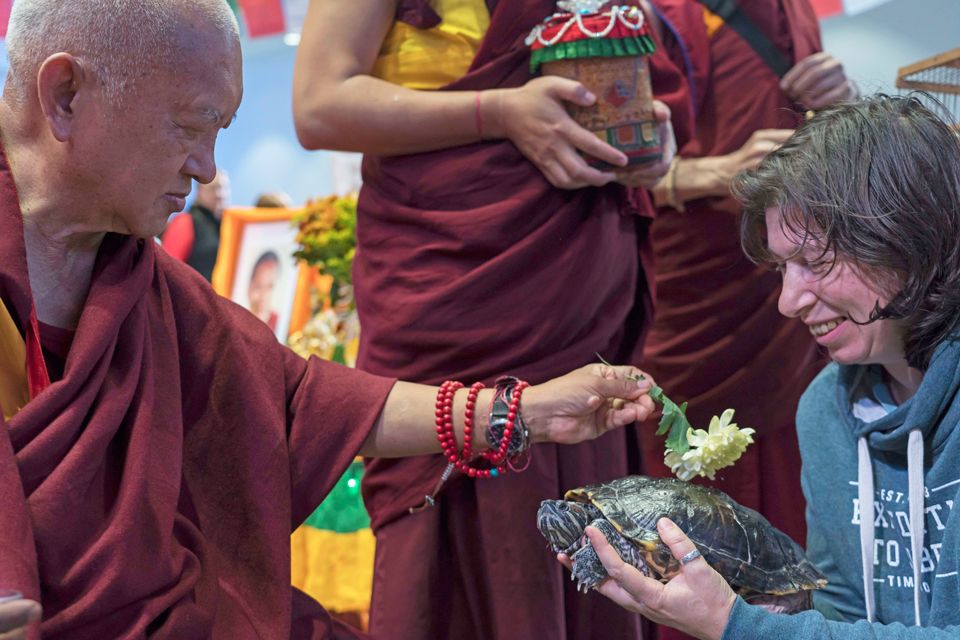
Lama Zopa Rinpoche blessing a turtle at the animal blessing organized by Ganden Tendar Ling, Moscow, Russia, September 2019. Photo by Ven. Lobsang Sherab.
Wherever Lama Zopa Rinpoche travels in the world, he is sure to do practices that benefit animals. While in Russia recently, Rinpoche attended two animal blessing events.
When Rinpoche first arrived in Moscow in late September, he attended an animal blessing day organized by students at Ganden Tendar Ling. About 700 people and pets came to the event with Rinpoche. Before Rinpoche’s arrival, information had been shared on how to benefit and provide Dharma care for animals.
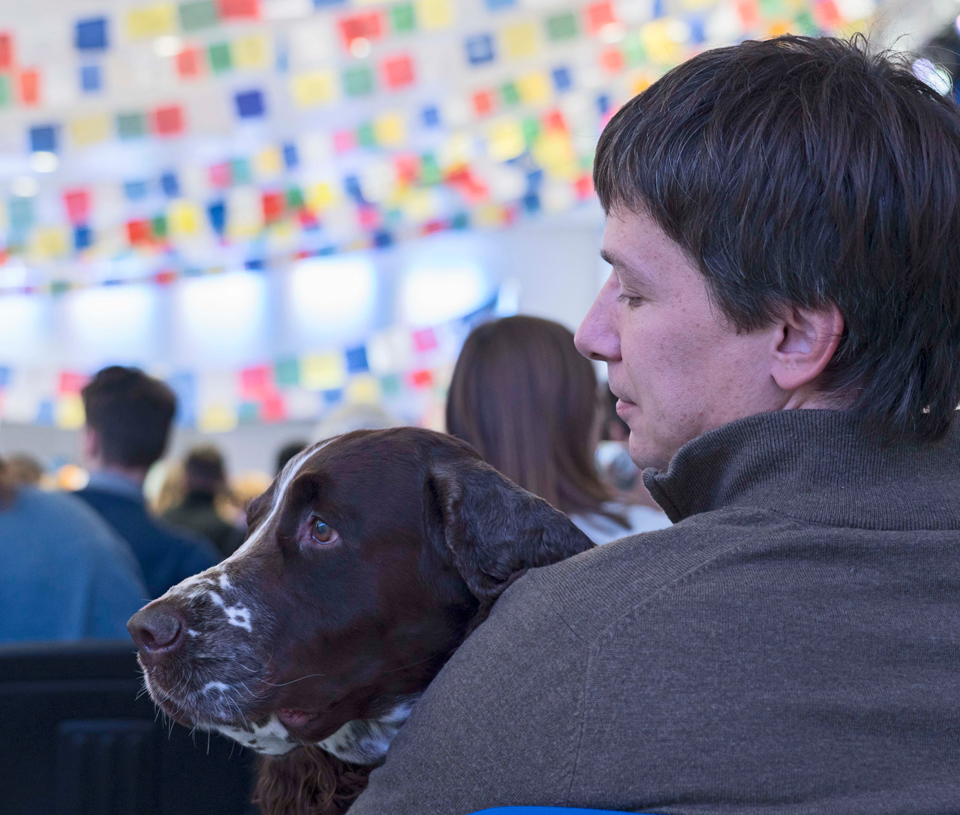
Dog at animal blessing organized by Ganden Tendar Ling, Moscow, Russia, September 2019. Photo by Ven. Lobsang Sherab.
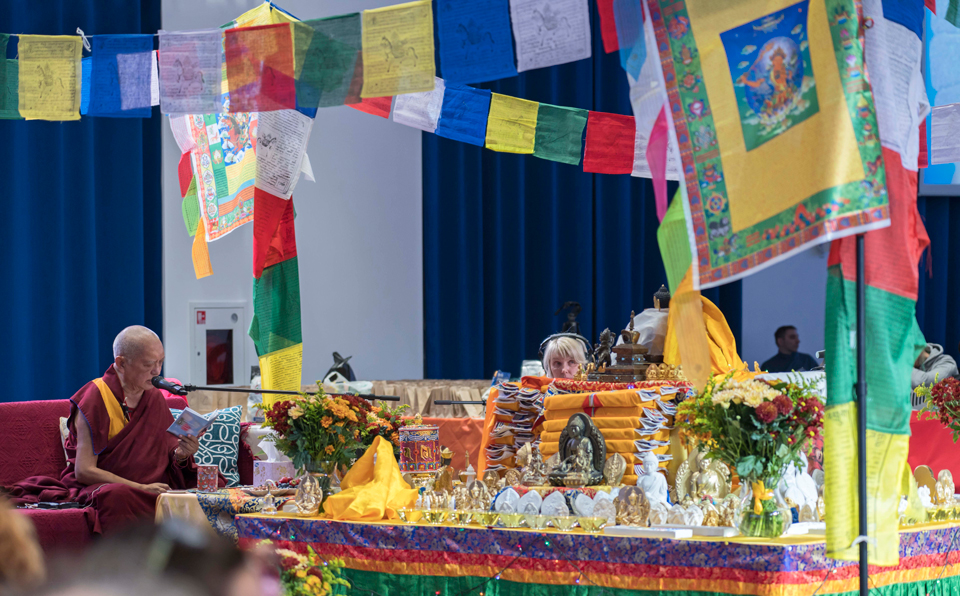
Lama Zopa Rinpoche and altar created for animal blessing organized by Ganden Tendar Ling, Moscow, Russia, September 2019. Photo by Ven. Lobsang Sherab.
At the Ganden Tendar Ling event, Rinpoche gave a Dharma talk and blessed food and water for animals. Pets and their people circumambulated around an altar that had been created for the event. Rinpoche also recited many mantras for the animals to hear.
Rinpoche did another animal blessing event while he was in Kalmykia, Russia, on October 19. In addition to many pets, Rinpoche also blessed farm animals. The next day Rinpoche traveled to the Capsian Sea and blessed the animals in the water.
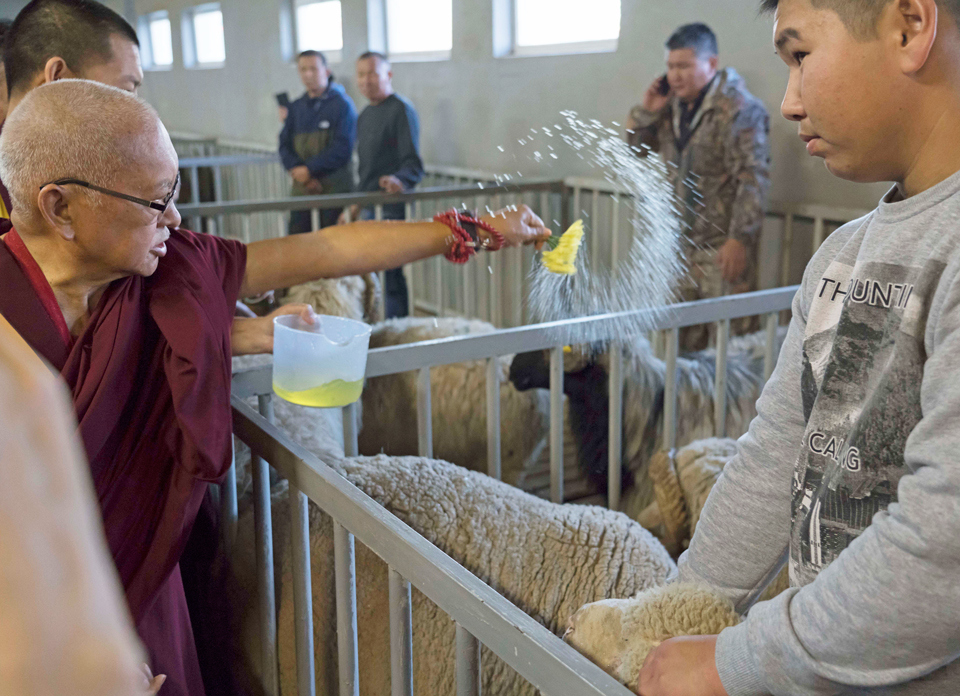
Rinpoche blessing sheep in Elista, Kalmykia, Russia, October 2019. Photo by Ven. Lobsang Sherab.

A girl and her cat at the animal blessing event with Lama Zopa Rinpoche in Elista, Kalmykia, Russia, October 2019. Photo by Ven. Lobsang Sherab.
Rinpoche has said that our animal friends are relatives from this life and past lives and that we need to care for them in the best way. Rinpoche has recommended many practices for benefiting animals. Some recommendation are as simple as playing recordings of mantras, sutras, and prayers for your pets at home.
Listen to and watch Lama Zopa Rinpoche reciting mantras to bless animals:
https://youtu.be/wTGpef4WQb4
FPMT Education Services has collected Rinpoche’s advice and practices to benefit animals. Students can learn more online:
https://fpmt.org/education/prayers-and-practice-materials/benefiting-animals-practices-and-advice/
See more photos from Lama Zopa Rinpoche’s visit to Russia:
https://fpmt.org/teachers/zopa/gallery/russia-september-october-2019/
Lama Zopa Rinpoche is the spiritual director of the Foundation for the Preservation of Mahayana Tradition (FPMT), a Tibetan Buddhist organization dedicated to the transmission of the Mahayana Buddhist tradition and values worldwide through teaching, meditation and community service.
- Tagged: animals, ganden tendar ling, kalmykia, lama zopa rinpoche, lama zopa rinpoche video short, moscow, russia, video
13
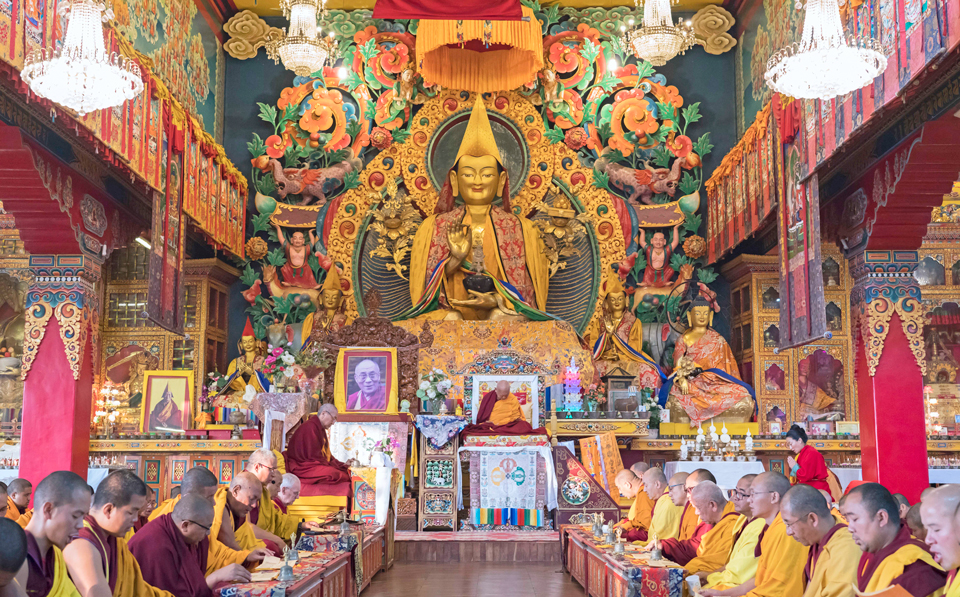
Khadro-la, Khen Rinpoche Geshe Chonyi, and the monks and nuns of Kopan doing the 1,000 offerings to Namgyalma puja for Lama Zopa Rinpoche’s birthday, Kopan Monastery, December 2019. Photo by Ven. Lobsang Sherab.
Kopan Monastery, in Nepal, honored Lama Zopa Rinpoche by offering Rinpoche a birthday celebration on December 3.
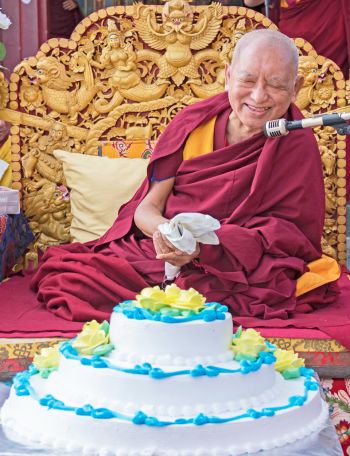
Lama Zopa Rinpoche and cake offered during the birthday celebration, Kopan Monastery, December 2019. Photo by Ven. Lobsang Sherab.
Rinpoche’s birthday celebration began with the monks and nuns from Kopan Monastery doing the 1,000 offerings to Namgyalma puja for Rinpoche. Then, outside in the courtyard, Rinpoche was offered a birthday cake along with a program of music, drama, and dance.
Khadro-la (Rangjung Neljorma Khadro Namsel Drönme) and Kopan abbot Khen Rinpoche Geshe Chonyi attended the celebration events. In addition to the Kopan monks and nuns, students from the month-long Kopan course and local community members were also at the celebration in the courtyard.
Ven. Lobsang Sherab created a 23-minute video of the celebration. The video captures the joyousness of the occasion, which includes scenes from:
- the 1,000 offerings to Namgyalma puja in the main Kopan gompa,
- the offering of a body, speech, and mind mandala to Rinpoche,
- Rinpoche’s advice about how to think when offering and cutting a birthday cake,
- young monks singing “Happy Birthday” and offering khatas to Rinpoche,
- the chanting of Rinpoche’s long life prayer composed by Khadro-la,
- a Dharma play offered by the monks,
- song and dance offered by the Tamang community from Namgyal Jangchub Choeling, and
- song and dance offered by the Thamichhowa Sherpas.
Watch Lama Zopa Rinpoche’s birthday celebration at Kopan Monastery:
https://youtu.be/eKb20697o3k
Find links to recordings of Rinpoche’s recent teachings from Nepal, Russia, Singapore, Latvia, France, and more:
https://fpmt.org/media/streaming/teachings-of-lama-zopa-rinpoche/
Lama Zopa Rinpoche is the spiritual director of the Foundation for the Preservation of Mahayana Tradition (FPMT), a Tibetan Buddhist organization dedicated to the transmission of the Mahayana Buddhist tradition and values worldwide through teaching, meditation and community service.
6
Devotion and Compassion Are the Best Puja
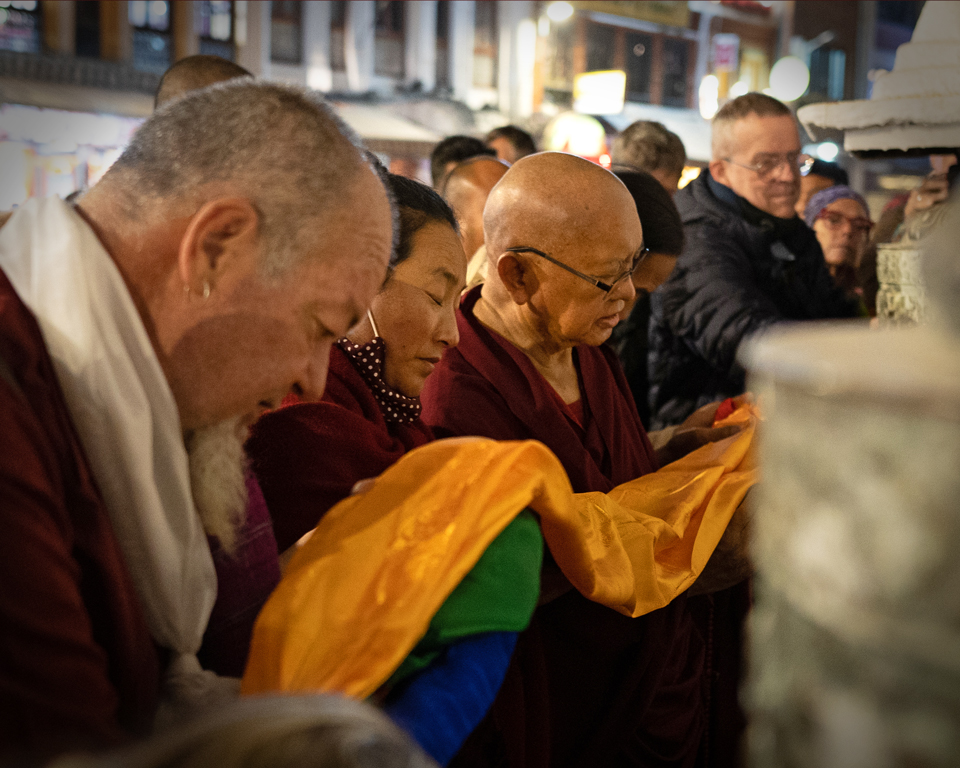
Lama Zopa Rinpoche and Khadro-la offering a khata at Boudha Stupa, Nepal, November 2019. Photo by Harald Weichhart.
Lama Zopa Rinpoche gave the following advice to Dharma centers on what to do when experiencing difficulties.
When your luck/controlling power is down, then obstacles come. (You are blamed for things even if you haven’t done them.) To make life easy, it is very important to have pujas for protection performed. Otherwise, problems come one after another. You may receive a lot of complaints from people. This also depends on how much luck/controlling power the center’s leader/director has. For the center to receive help means that it needs the karma to receive help; a lot depends on the leader, too.
Buddhism is full of methods to protect from obstacles, so we can use those. If something is beyond people’s intelligence, they can’t do anything; they can only do things if they know what to do.
It is good if centers can do things such as Medicine Buddha and Tara puja. I have been saying how Medicine Buddha puja is very powerful for success. Also, they must do regular protector prayers.
The most important thing for success is devotion and compassion—this is the cause for harmony. That is the best puja. Compassion for others cuts down on problems, and people will help you.
Devotion collects so much merit; good samaya leads to inner and outer prosperity; there is the wisdom to discriminate what is right, and everything goes well.
For example, in the USA, there are so many religions, but when problems occur, they don’t use religion, they just use politics, not spirituality. We are a Dharma organization so there is so much that you can do. Some centers have a resident teacher who can do divinations and analysis and give spiritual support to the center through practices and pujas—at the beginning of each year, like in the monasteries, or every six months is best. If some problems are about to come which you can’t predict, it is better to do pujas every six months (like Geshe Lama Konchog used to advise, and Kopan Monastery does). This will reduce problems and bring more peace.
Some things are very simple, like making a tea offering, but it can still help a lot.
From the advice “Protection from Obstacle,” given by Lama Zopa Rinpoche and published on the Lama Yeshe Wisdom Archive:
https://www.lamayeshe.com/advice/protection-obstacles
Links to watch Lama Zopa Rinpoche’s live teachings currently taking place at Kopan Monastery in Nepal:
https://fpmt.org/media/streaming/lama-zopa-rinpoche-live/
Find links to recordings of Rinpoche’s recent teachings from Nepal, Russia, Singapore, Latvia, France, and more:
https://fpmt.org/media/streaming/teachings-of-lama-zopa-rinpoche/
Lama Zopa Rinpoche is the spiritual director of the Foundation for the Preservation of Mahayana Tradition (FPMT), a Tibetan Buddhist organization dedicated to the transmission of the Mahayana Buddhist tradition and values worldwide through teaching, meditation and community service.
- Tagged: lama zopa rinpoche, problems
2
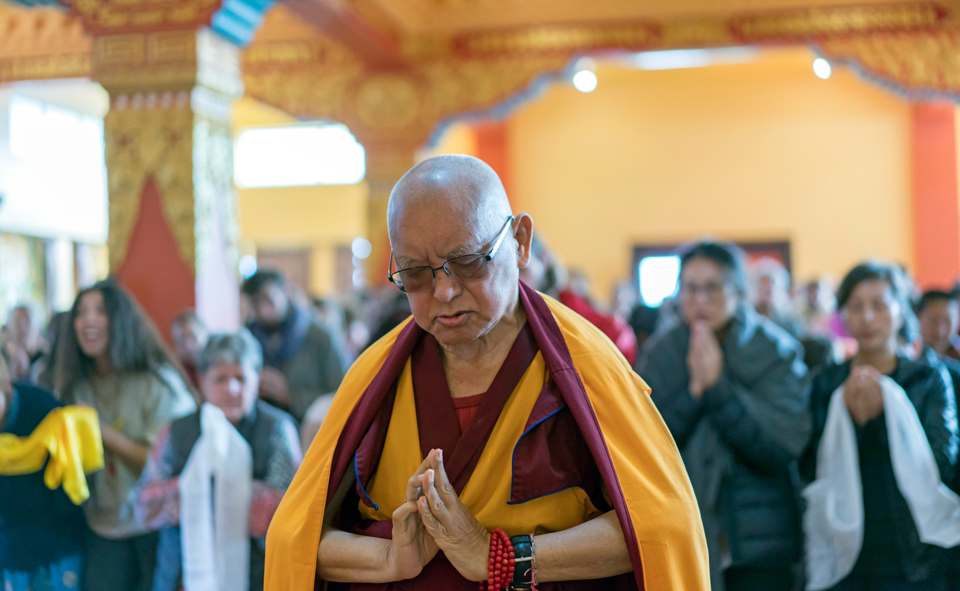
Lama Zopa Rinpoche with students attending the month-long lamrim course at Kopan Monastery in the newly rebuilt Chenrezig gompa, Nepal, November 2019. Photo by Ven. Lobsang Sherab.
Lama Zopa Rinpoche’s birthday is celebrated on Tuesday, December 3. This year Rinpoche is at Kopan Monastery, where he is giving teachings to more than 250 students from around the world as part of the month-long lamrim course there.
Last year, Rinpoche sent out a video message to students on his birthday. In the video, Rinpoche gives advice on how to best see one’s birthday and the practices that can be done that become the causes for total and complete enlightenment for oneself and for all sentient beings.
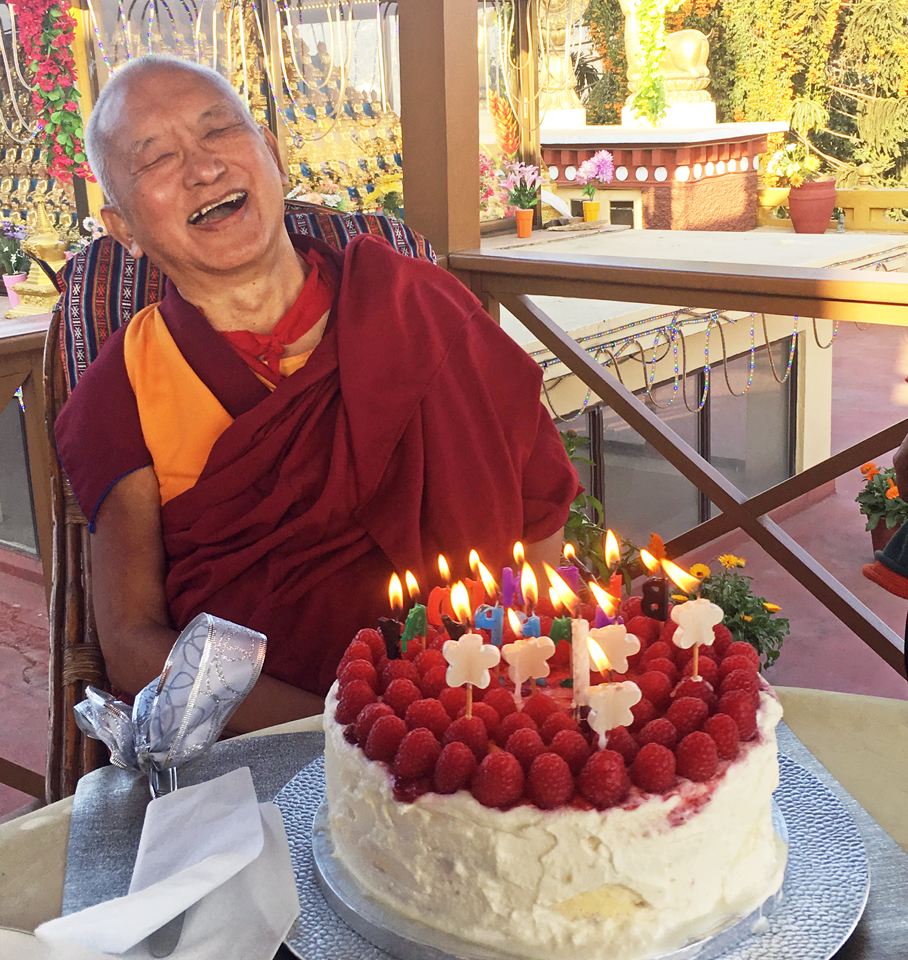
Lama Zopa Rinpoche with a birthday cake offered to him, Kopan Monastery, Nepal, 2016.
Rinpoche’s teachings at the course are being webcast live at approximately 3:30 pm local time (GMT+5:45), although the time may be subject to change. Teachings are being streamed in English and French, and a live transcript will also be available.
Links for Lama Zopa Rinpoche’s live teachings at Kopan Monastery:
https://fpmt.org/media/streaming/lama-zopa-rinpoche-live/
Lama Zopa Rinpoche is the spiritual director of the Foundation for the Preservation of Mahayana Tradition (FPMT), a Tibetan Buddhist organization dedicated to the transmission of the Mahayana Buddhist tradition and values worldwide through teaching, meditation and community service.
Find links to recordings of Rinpoche’s recent teachings from Russia, Singapore, Latvia, France, and more:
https://fpmt.org/media/streaming/teachings-of-lama-zopa-rinpoche/
Learn about Kopan Monastery and the courses on Buddhism offered there:
https://kopanmonastery.com/
Watch Lama Zopa Rinopche’s Birthday Message from 2018:
https://youtu.be/ajT7srFuHw8
- Tagged: birthday, kopan course, kopan monastery, lama zopa rinpoche
29

Lama Zopa Rinpoche at Kopan Monastery, Nepal, November 2019. Photo by Bill Kane.
Lama Zopa Rinpoche arrived at Kopan Monastery in Nepal on Tuesday, November 26. Rinpoche is giving daily teachings now as part of the month-long lamrim Kopan course, which takes place every November. This is the fifty-second Kopan month-long lamrim course. It is taking place in the newly rebuilt Chenrezig gompa, which had been significantly damaged by the 2015 earthquake in Nepal and had to be completely rebuilt.
Rinpoche’s teachings at the course are being webcast live at approximately 3:30 pm local time (GMT+5:45), although the time may be subject to change. Teachings are being streamed in English and French, and a live transcript will also be available.
Links for Lama Zopa Rinpoche’s live teachings at Kopan Monastery:
https://fpmt.org/media/streaming/lama-zopa-rinpoche-live/
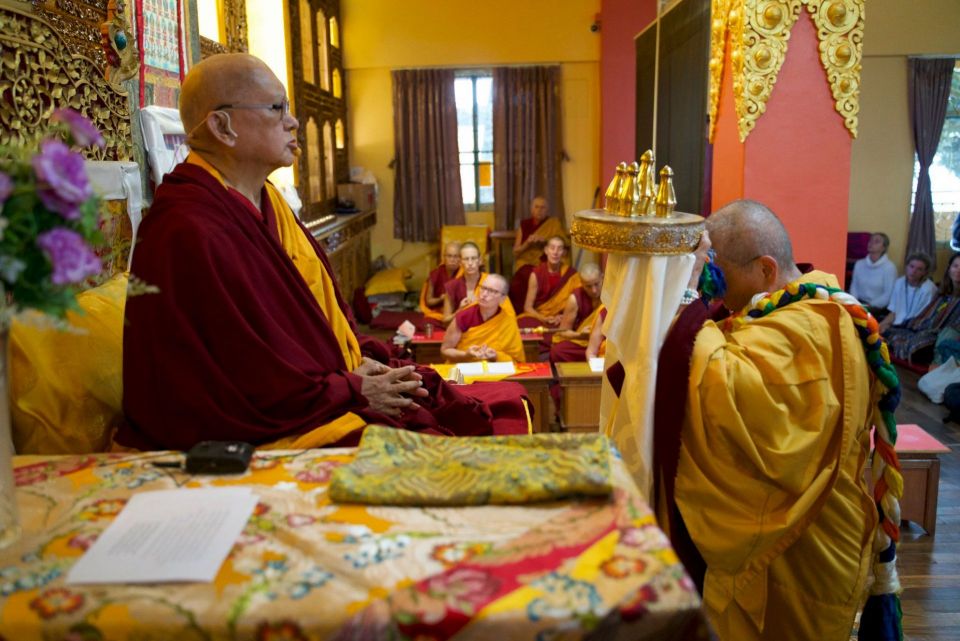
Lama Zopa Rinpoche being offered a mandala during the month-long Kopan course, which is taking place in the newly rebuilt Chenrezig gompa, Kopan Monastery, Nepal, November 2019. Photo by Bill Kane.
Lama Zopa Rinpoche is the spiritual director of the Foundation for the Preservation of Mahayana Tradition (FPMT), a Tibetan Buddhist organization dedicated to the transmission of the Mahayana Buddhist tradition and values worldwide through teaching, meditation and community service.
Find links to recordings of Rinpoche’s recent teachings from Russia, Singapore, Latvia, France, and more:
https://fpmt.org/media/streaming/teachings-of-lama-zopa-rinpoche/
Learn about Kopan Monastery and the courses on Buddhism offered there:
https://kopanmonastery.com/
27
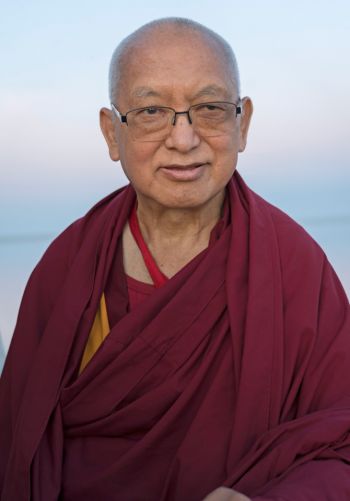
Lama Zopa Rinpoche during a visit to the Caspian Sea to bless all the beings in the sea, Russia, October 2019. Photo by Ven. Lobsang Sherab.
This year, the holiday of Thanksgiving is celebrated in the United States on Thursday, November 28. Lama Zopa Rinpoche offered the following advice on how to help the tens of millions of turkeys being killed for the holiday. (For the most up to date version of this advice, please see the page “Prayers and Practices to Do for Turkeys at Thanksgiving”.)
My dear students and dear friends who want to help all sentient beings and, in particular, the animals that are killed, specifically all the turkeys killed during Thanksgiving,
Approximately forty-six million turkeys are killed for Thanksgiving, and then also approximately twenty-two million turkeys are killed for Christmas.
My suggestion on how we can benefit the turkeys is to recite the Five Powerful Mantras:
- Mantra of Kunrig
- Stainless Pinnacle Lotus Mantra
- Stainless Beam Mantra (recite one mala of this main mantra)
- Mantra of Buddha Mitrugpa
- Stainless Lotus Pinnacle Mantra of Amoghapasha
Extra mantras you can recite:
- the Chenrezig mantra (short)
- the Namgyalma mantra (short)
If you can, recite each mantra twenty-one times, or as many times as you like. You can also recite the OṂ MAṆI PADME HŪṂ mantra (Chenrezig mantra), which, of course, contains all the entire Buddhadharma. If you can, recite one mala of OṂ MAṆI PADME HŪṂ—or if you want to recite more, that is even better. Then, as well as the Five Powerful Mantras, you can also recite the Namgyalma mantra.
I checked many mantras to see what would benefit the turkeys, but the other mantras did not come out. According to my observation, the main mantra to recite is the Stainless Beam Mantra. This is what comes out most beneficial for the turkeys. It says in the Kangyur that if you recite the Stainless Beam Mantra seventy times, if a being has been born in the lower realms, they will definitely get liberated from there.
So, please, if you can, recite one mala of the Stainless Beam Mantra dedicated to the turkeys killed for Thanksgiving and also for Christmas.
You can visualize that nectar beams, like sun beams, are emitted from the deity to you and to every sentient being, and in particular to the turkeys. The beams totally illuminate you, your family, and all sentient beings, and in particular the turkeys. Keep reciting the mantra with this visualization.
Recite it with strong concentration and an undistracted mind. Don’t recite the mantra with your mind thinking about the beach or sightseeing in the mountains, such as Mount Everest.
You can also recite the mantras and dedicate for the people who kill the turkeys.
You can think that you yourself are the turkeys that are going to be killed. Think of yourself in that situation. How would you feel? From that, you will then understand the incredible urgency to have someone help you and pray for you. You will then understand how important that is.
Feel this need for the prayers very strongly. And not only for all the turkeys killed this year at Thanksgiving and Christmas, but also, in general, for all animals that are killed. So many animals are killed—an unbelievable, unbelievable amount. The need for prayers for them is so urgent.
You can also use these mantras in your everyday life when you want to pray for people or animals who have died. It’s very important to know and become familiar with these mantras.
Please recite the mantras with strong bodhichitta.
Thank you very much. Sorry for making my noise, like buzzing in your ear. Thank you very much for your patience.
With much love and prayers,
Lama Zopa
Scribed by Ven. Holly Ansett, Singapore, November 26, 2019; edited by Ven. Ailsa Cameron. Lightly edited for inclusion on FPMT.org.
Five Powerful Mantras and the Namgyalma Mantra
OṂ NAMO BHAGAVATE / SARVA DURGATI PARIŚHODHANA RĀJĀYA / TATHĀGATĀYA / ARHATE SAṂYAKSAṂBUDDHAYA / TADYATHĀ / OṂ ŚHODHANE / ŚHODHANE / SARVA PĀPAṂ VIŚHODHANE / ŚHUDDHE VIŚHUDDHE / SARVA KARMA AVARANA VIŚHUDDHE SVĀHĀ
2. Stainless Pinnacle Lotus Mantra
OṂ NAMAS TRAIYADHVIKĀNĀṂ / SARVA TATHĀGATA HRĪDAYA GARBHE JVALA JVALA / DHARMADHATU GARBHE / SAMBHARA MAMA ĀYUḤ SAṂŚHODHAYA MAMA SARVA PĀPAṂ / SARVA TATHĀGATA SAMANTOṢHṆĪṢHĀ VIMALE VIŚHUDDHE HUṂ HUṂ HUṂ HUṂ / AṂ VAṂ SAṂ JA SVĀHĀ
OṂ SARVA TATHĀGATA MALA VIŚHODHAṆI RUDDHA / VOLA PRATI SAṂKARA / TATHĀGATĀ / DHATU DHARE / SAṂDHARA SAṂDHARA / SARVA TATHĀGATA ADHIṢHṬHĀNA ADHIṢHṬHITE SVĀHĀ
NAMO RATNA TRAYĀYA / OṂ KAṂKANI KAṂKANI / ROCHANI ROCHANI / TROTANI TROTANI / TRĀSANI TRĀSANI / PRATIHANA PRATIHANA / SARVA KARMA PARAṂ PARĀṆIME SARVASATVA NAÑCHA SVĀHĀ
5. Stainless Lotus Pinnacle Mantra of Amoghapasha
OṂ PADMO UṢHṆĪṢHA VIMALE HŪṂ PHAṬ
OṂ BHRŪṂ SVĀHĀ / OṂ AMṚITA ĀYUR DADE SVĀHĀ
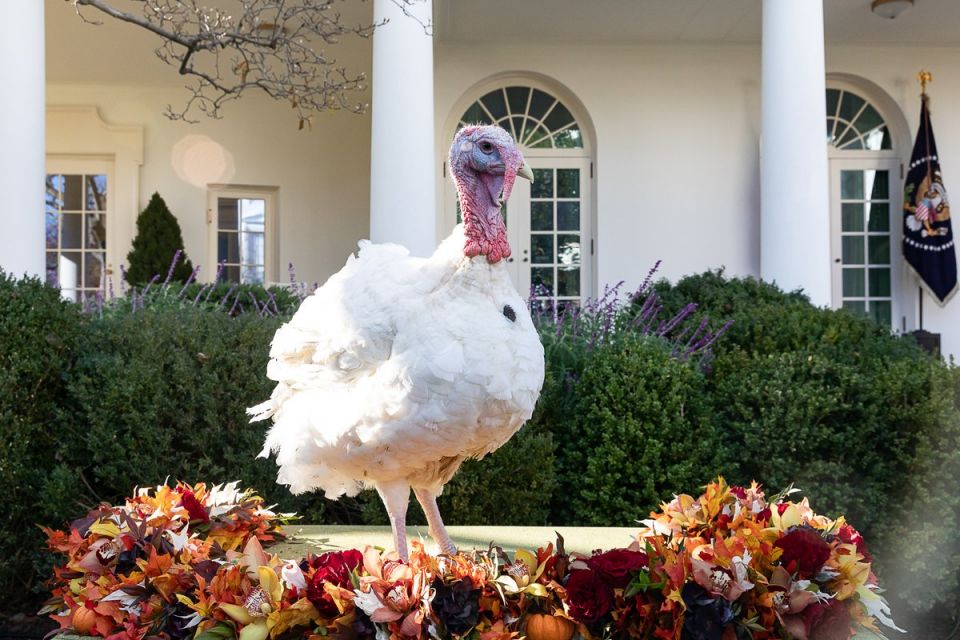
Peas, a 39-pound (18-kilogram) Broad Breasted White turkey from Huron, South Dakota, poses after being chosen for pardoning at the 2018 National Thanksgiving Turkey Presentation in Washington, DC. Photo by Unnamed White House staffer – Official White House social media: https://twitter.com/WhiteHouse/status/1065045640122642432, Public Domain, https://commons.wikimedia.org/w/index.php?curid=74554246
Lama Zopa Rinpoche is the spiritual director of the Foundation for the Preservation of Mahayana Tradition (FPMT), a Tibetan Buddhist organization dedicated to the transmission of the Mahayana Buddhist tradition and values worldwide through teaching, meditation and community service.
For more mantras and resources for mantra recitation, visit FPMT Education Services’ page on mantras:
https://fpmt.org/education/prayers-and-practice-materials/mantras/
- Home
- News/Media
- Study & Practice
- About FPMT Education Services
- Latest News
- Programs
- New to Buddhism?
- Buddhist Mind Science: Activating Your Potential
- Heart Advice for Death and Dying
- Discovering Buddhism
- Living in the Path
- Exploring Buddhism
- FPMT Basic Program
- FPMT Masters Program
- FPMT In-Depth Meditation Training
- Maitripa College
- Lotsawa Rinchen Zangpo Translator Program
- Universal Education for Compassion & Wisdom
- Online Learning Center
- Prayers & Practice Materials
- Overview of Prayers & Practices
- Full Catalogue of Prayers & Practice Materials
- Explore Popular Topics
- Benefiting Animals
- Chenrezig Resources
- Death & Dying Resources
- Lama Chopa (Guru Puja)
- Lama Zopa Rinpoche: Compendium of Precious Instructions
- Lama Zopa Rinpoche: Life Practice Advice
- Lama Zopa Rinpoche Practice Series
- Lamrim Resources
- Mantras
- Prayer Book Updates
- Purification Practices
- Sutras
- Thought Transformation (Lojong)
- Audio Materials
- Dharma Dates – Tibetan Calendar
- Translation Services
- Publishing Services
- Teachings and Advice
- Find Teachings and Advice
- Lama Zopa Rinpoche Advice Page
- Lama Zopa Rinpoche: Compendium of Precious Instructions
- Lama Zopa Rinpoche Video Teachings
- ༧སྐྱབས་རྗེ་བཟོད་པ་རིན་པོ་ཆེ་མཆོག་ནས་སྩལ་བའི་བཀའ་སློབ་བརྙན་འཕྲིན།
- Podcasts
- Lama Yeshe Wisdom Archive
- Buddhism FAQ
- Dharma for Young People
- Resources on Holy Objects
- Ways to Offer Support
- Centers
- Affiliates Area
- Teachers
- Projects
- Charitable Projects
- Make a Donation
- Applying for Grants
- News about Projects
- Other Projects within FPMT
- Support International Office
- Projects Photo Galleries
- Give Where Most Needed
- FPMT
- Shop
Translate*
*powered by Google TranslateTranslation of pages on fpmt.org is performed by Google Translate, a third party service which FPMT has no control over. The service provides automated computer translations that are only an approximation of the websites' original content. The translations should not be considered exact and only used as a rough guide.Be as careful as you can. Our minds are funny. Sometimes we are skeptical of things that are really worthwhile and completely accepting of things that we should avoid. Try to avoid extremes and follow the middle way, checking with wisdom wherever you go.







